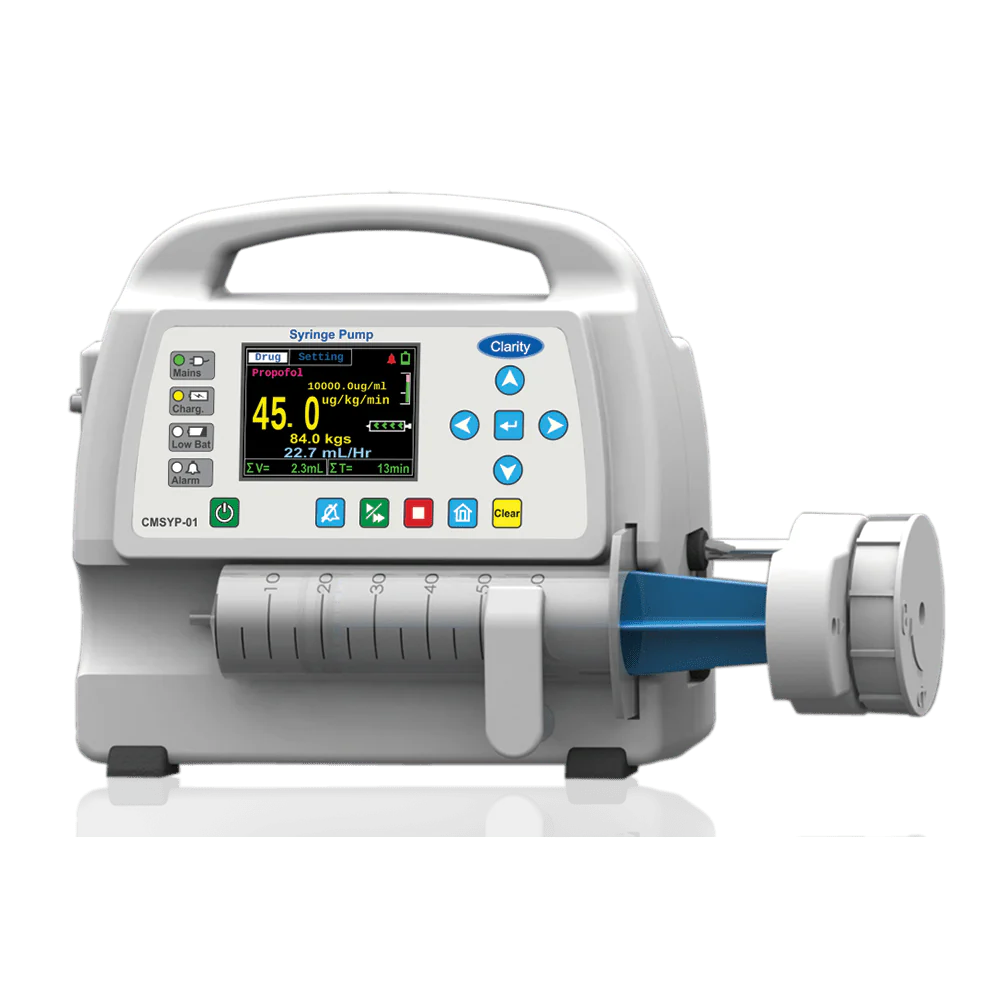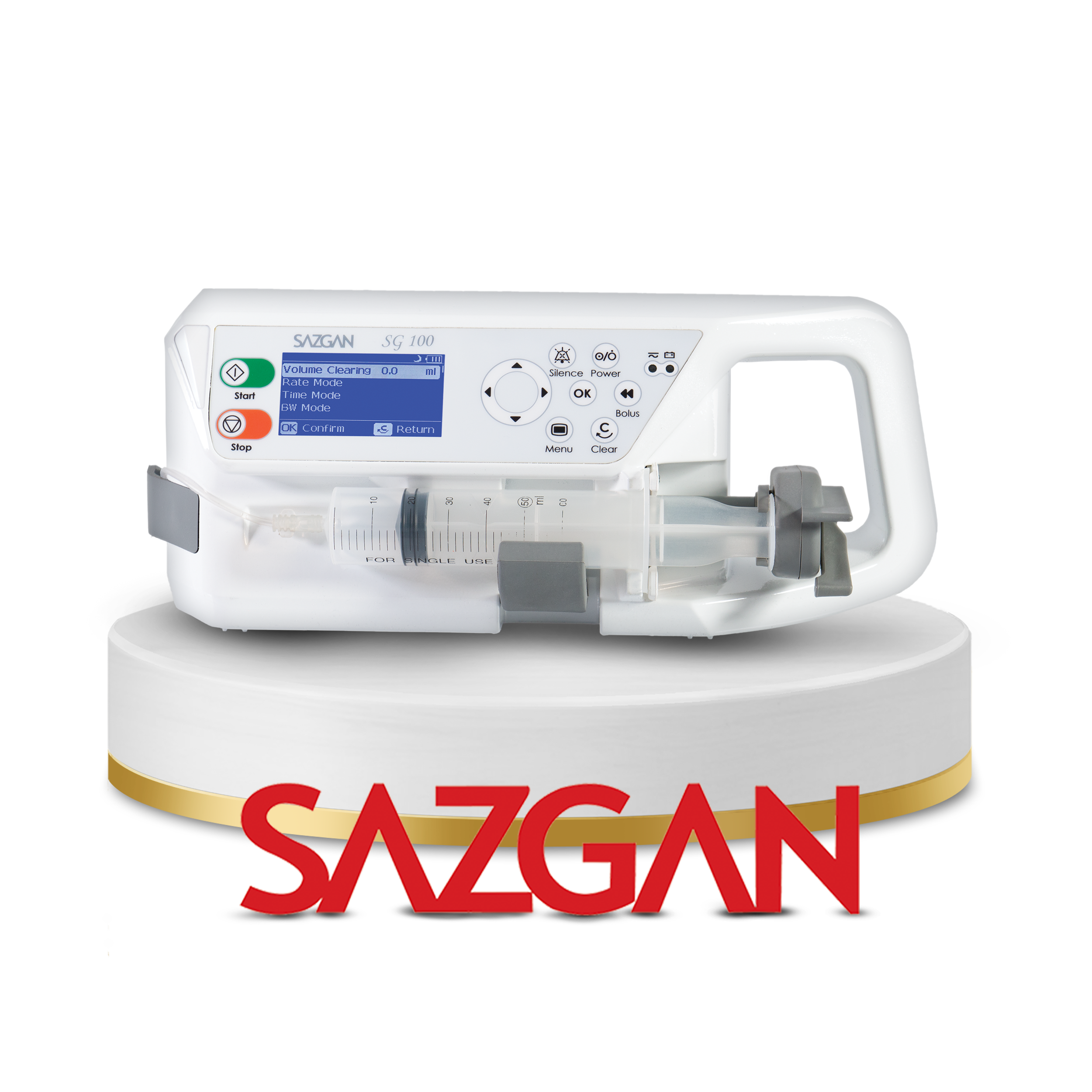All about syringe pumps and serum pumps

All about syringe pumps and serum pumps
Serum injection pump (peristaltic pump or volumetric pump-infusion pump):
Infusion pumps are devices that are used for the planned injection of fluids into the patient’s body, which perform drug injection using serum sets and micro sets. These pumps are generally used to inject drugs, fluids and blood products in large volume and its task is to regulate and display the amount of serum flow injected into the patient’s vein. So that their injection volume usually ranges from a few cc to several liters. The operation method of these devices is divided into two categories: VOLUMETRIC and DRIP COUNTING.

Principles of operation of the serum pump device:
The pump infusion device weighs about 2 kg and can be installed on a special base. These pumps have different types and capabilities. Some devices are single-channel, while others have multiple channels that can simultaneously perform the injection operation through two or more sets of serum and can replace several single-channel pumps that are connected to a patient. These pumps have a liquid bag to which a handle or a hook is hung above the pump and a tube is connected to it. Inside the pump, the liquid-filled tube is fixed on a series of small gears and a roller. When the roller moves and the ribs start to move, the liquid is transferred from the tube to the patient. The user sets the liquid flow rate and its required volume on the device, so the gears and roller start moving according to the set speed. Whenever the required volume of liquid is released, a special alarm sounds. The tube passes through an air-in-line sensor and as soon as the air bubble passes, the alarm sounds and the liquid flow stops. Volumetric injection pumps monitor the amount of liquid pressure, which results in controlling the pressure of the injected liquid and preventing damage to the patient’s vein during a possible increase in the injection pressure. When the pressure increases too much, the injection tube occlusion alarm will notify the user.
Volumetric infusion pump:
The function of the volume infusion pump is similar to that of circulating dialysis pumps (ROLLER PUMPS), which measures the volume inside the serum set and injects it to the patient due to the constant diameter of the serum set. Therefore, the injection accuracy of this type of device depends on the diameter of the serum set used. For this reason, for injection with this type of device, you should use only the special serum set of the device that is introduced or made by the company.
Dropper pumps:
The second category is dropper pumps that estimate the volume under injection by counting the number of drops with an electronic dropper eye. According to the standard of micro sets, every 60 drops in this set should be equal to 1 cc, and in macro sets, 15 or 20 drops will be equal to this volume. Therefore, in these pumps, the most important point to determine the accuracy of the device is to know how many drops are equal to 1 cc. In some of these devices, this number is limited to a few important choices, such as 15-20-60, and in some other devices, the selectable number is more, and for using Iranian sets, the existence of this capability means the ability to choose different values between 15 and 25 things are considered necessary. Infusion pump devices should be sensitive to blockage and stop the injection if there is between 50 and 100 microliters of air in the infusion set.
In general, volimetric devices have these two advantages, firstly, they are highly accurate, and due to the high accuracy of this device in injection, it can be used in applications such as continuous epidural anesthesia, injection of cardiovascular drugs, chemotherapy, blood transfusion, pediatrics, and serum therapy. used. Secondly, it is much easier to use them. But the main problem is the unaffordability of their set prices. On the other hand, the advantage of drop counter devices is the use of cheap sets, but it should be noted that these devices must be set in such a way that the injection accuracy does not decrease.
Features of infusion pumps:
Blous: This feature enables the operator to inject a small amount of medicine at a high speed and with pressure without stopping during the injection.
Adjusting the injection speed
VOLUME TO BE INFUSED (VBI): In this case, the volume and final dose of the drug can be defined for the device. In this way, when the desired volume or dose is injected, the device automatically stops and sounds an alarm.
KEEP VEIN OPEN (KVO): If the injection is stopped for any reason, a small amount of medicine is injected to the patient at a very low speed to prevent the blockage of the needle head and the closing of the vein.
(SBS) STEP BY STEP: This feature is for when we want to inject a medicine to the patient in different times and with the same volumes and speeds and see the total volume at the end.
Alarm system: Most of the infusion pumps, in emergency situations that are defined for the device, start to alarm and inform the operator of the current situation. Some of the things that lead to the start of the alarm are: running out of medicine, the presence of bubbles in the injection path, high injection pressure and so on. . .
Pressure control in the system: Most pumps have the ability to measure and display injection pressure at any moment. Also, the injection pressure can be adjusted by controlling the pump flow in most devices.
Information about the presence of air bubbles in the injection path: two methods can be used for this purpose.
Optical transducers that cannot be used today due to limitations in detecting air bubbles when using colored serum sets and colored drugs.
Ultrasonic transducers, which have higher accuracy and do not depend on the color of the drug.
Drop detector: optical sensors are used for this purpose.
PIGGYBACK function: using this function, the operator will be able to program two injections with two different amounts and two different speeds. So that the device starts the second mode after finishing the first mode and sounds an alarm at the end.
portable
Syringe injection pump:
In the intensive care unit and after surgery, there are many cases where an effective substance enters the patient’s blood continuously and for a certain period of time. In such cases, accuracy in the injection rate and its regularity are very important. For such purposes, a device called a syringe injection pump is used, and this device is used in almost all intensive care units, especially in the cardiac intensive care unit. Since the inner diameter of the syringe is generally standard and fixed, the injection speed can be controlled by adjusting the linear speed of the syringe piston. Normally, these devices are used to inject drugs in small volumes, because they generally use 5 cc to 50 cc syringes. Since the accuracy of this device is 0.1 CC/hr, when using them, drugs are generally diluted less, which is an advantage. Because in many cases, a large volume of liquids is very harmful, and if it is possible to inject the patient’s medicine in a small volume without interfering with the accuracy of the device, it will have a significant effect on the quality of treatment. This issue has caused the syringe pump to be used more than the infusion pump in cardiac departments and CCUs. When using Iranian syringes, it should be noted that the inner diameter of the syringes is standard, otherwise, devices that allow defining the inner diameter of the syringe should be used. In fact, the device that has this possibility works in Iran, otherwise only standard syringes should be used. For this purpose, the device can be adjusted for a type of syringe with a specific brand and ensure that this brand of syringe is used in the treatment department for at least a few months. It is natural that by changing the brand

Principles of syringe injection pump operation:
This device weighs about 2 kg, which can be installed on a special base and includes a mechanical part and an electrical part.
Mechanical part: In this device, there is a pump that injects liquid at a set rate by advancing the syringe piston. In most syringe pumps, a stepper motor drives the lead screw. The speed of this motor is adjusted depending on the flow rate and the size of the syringe. The mechanical part of the device is responsible for converting the rotary movement of the motor into a linear movement to push the syringe piston forward. Through the pulses applied to the stepper motor, the degree of rotation of the motor axis is determined. By using a round gear and turning a screw connected to a stepper motor, the lever moves forward and presses the syringe. In the feedback section, through the potentiometer connected to the end of the lever, any possible error in the amount of rotation of the motor axis or the amount of movement of the lever is revealed and corrected in the output of the device. The amount of injection flow is adjusted according to the diameter of the syringe and the speed of the syringe piston.
Electrical part: In the electronic part of the device, based on the input information, the requested injection rate parameters are set and sent to the stepper motor driver through specific electrical pulses. Also, if needed, all alarms of the device will be activated through the sensors embedded in it and the measurement of the required parameters and software control.
Common alarms in the syringe pump device:
X Min PRE ALARM, which indicates that the injection will end in X minutes, X is not more than 5.
Low BATTERY
VERY LOW BATTERY
Occlusion
No MAIN indicates power failure during injection
Important parameters for testing and calibration tests:
Check the output volume of the device
Checking the average output volume rate
Check back pressure
Check injection time
Checking the fluctuations of the output flow with time
Checking the accumulated volume
safety tips :
Avoid using the device in wet places or wet ground in order to avoid short circuit.
Do not use the pump in the place where chemicals are stored or where there are explosive anesthetic gases.
Do not use the syringe barrel or its plunger to lift the pump.
Avoid filling 50 ml syringes beyond their capacity because the syringe may not be fully seated.
Always use earthed sockets to connect the device to electricity.
Never use connecting wires and tees to connect the device to electricity.
If the pump is hit or falls, do not use the device again before the approval of the service personnel.
Make sure that the two electrical plugs of the device are completely dry after washing and before using again.
Avoid putting pressure on the alarm lamps and the lamps indicating the operation of the machine during washing.
Methods of cleaning/disinfecting/sterilizing the device. Methods of cleaning/disinfecting the injection pump device:
Always turn off the device and unplug it before cleaning.
If drops of injectable liquid or other substances are splashed on the device while working with the device, immediately clean the spots with a wet cloth.
Clean the device at regular intervals with a damp cloth. To do this, follow the instructions below.
Avoid submerging the pump in water.
Do not use organic cleaners such as thinner and alcohol to clean the surface of the device.